1000/1000
Hot
Most Recent

| Version | Summary | Created by | Modification | Content Size | Created at | Operation |
|---|---|---|---|---|---|---|
| 1 | Il-Sup Kim | + 1776 word(s) | 1776 | 2021-04-20 06:12:54 | | | |
| 2 | Bruce Ren | -21 word(s) | 1755 | 2021-04-27 07:36:35 | | |
In addition to providing nutrients, food can help prevent and treat certain diseases. In particular, research on soy products has increased dramatically following their emergence as functional foods capable of improving blood circulation and intestinal regulation. In addition to their nutritional value, soybeans contain specific phytochemical substances that promote health and are a source of dietary fiber, phospholipids, isoflavones (e.g., genistein and daidzein), phenolic acids, saponins, and phytic acid, while serving as a trypsin inhibitor. These individual substances have demonstrated effectiveness in preventing chronic diseases, such as arteriosclerosis, cardiac diseases, diabetes, and senile dementia, as well as in treating cancer and suppressing osteoporosis. Furthermore, soybean can affect fibrinolytic activity, control blood pressure, and improve lipid metabolism, while eliciting antimutagenic, anticarcinogenic, and antibacterial effects.
Soybean is an excellent food resource as it contains high-quality protein, a high ratio of unsaturated fatty acids and dietary fiber, as well as other substances that possess various physiological functions [1]. Due to the recent westernization of the Korean diet, the prevalence of certain diseases, including diabetes and cardiovascular events, is increasing [2][3]. Moreover, considering that the overconsumption of animal-based food products is a contributor to the development of obesity, the functionality of soy, a plant-derived food product, is highlighted [1][4][5]. Soybean is composed of 40% protein, which is significantly higher than most other types of beans [5]. Furthermore, the high-quality protein in soy is equivalent to that found in dairy, meat, and eggs but lacks cholesterol and saturated fatty acids [1][4]. Moreover, the Food and Drug Administration (FDA) of the United States (US) recognized that the consumption of soy protein decreases the risk of cardiovascular diseases and applied the “healthy” food label, which increased public interest in soybean in the US, as well as Japan [6][7]. The consumption of soy protein by obese patients is effective in preventing and treating obesity [8][9]; not only does it inhibit fat accumulation and increase fat metabolism, but it also contributes to weight reduction by regulating the expression of appetite-suppressing factors [10]. Furthermore, the fermentation of soybean by effective bacteria, including Bacillus spp., produces certain enzymes and physiochemical substances that do not exist in the raw food product [11]. Soybean fermentation is accomplished by either Bacillus subtilis or Bacillus licheniformis, which weakens the putrefactive effect of intestinal bacteria, and resists pathogenic bacteria by absorbing toxic substances [12][13].
Soybean comprises lipids (18%), proteins (38%), carbohydrates (30%, 1:1 ratio of soluble and insoluble forms), and moisture, ash, and other substances (14%), which include vitamins and minerals that are not required in large quantities by the body (Figure 1A,B; Table 1). In relation to proteins, the nutritional value of soybean amino acids is as follows: tryptophan (1%), tyrosine (4%), valine (4%), arginine (8%), alanine (4%), aspartic acid (7%), cysteine (3%), glutamic acid (19%), glycine (4%), histidine (3%), phenylalanine (6%), isoleucine (5%), lysine (8%), leucine (8%), methionine (1%), proline (5%), serine (5%), and threonine (4%) (Figure 1C). Soybean is high in fiber, protein, and phytoestrogens, low in saturated fats, free cholesterol, and lactose, and a good source of omega-3 fatty acids and antioxidants. Moreover, the stable storage of soybean can be improved by the addition of 12–14% moisture [1][4]. Recently, much attention has been paid to soybean as a functional food because several studies have shown that it contains at least 14 beneficial phytochemical substances, including phytic acid, triterpenes, phenolics, flavonoids, lignans, carotenoids, and coumarins, as well as protease inhibitors, oligosaccharides, and dietary fibers [1][4][5][14][15]. These compounds have purported anticancer, antiaging, antirenal failure, antiobesity, and anticholesterolemic properties, while also being shown to inhibit HIV, and prevent gallstone formation, senile dementia, and hyperlipidemia. Furthermore, soybean promotes diuretic action, suppresses arteriosclerosis, provides relief from constipation, and prevents cardiovascular diseases (Figure 2) [15][16][17][18][19]. Soybean also contains substances that are involved in intestinal regulation, have antioxidative properties, prevent osteoporosis, lower blood pressure, have antithrombotic effects, boost immunity, and promote liver functions, and therefore, can be inferred to be closely related to the prevention of certain chronic diseases [15][16][17][18][19][20][21].
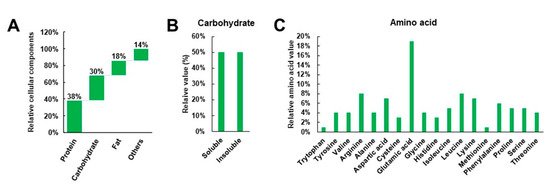
Figure 1. Nutritional value of carbohydrates, proteins, and fats (A), ratio of soluble and insoluble forms of carbohydrate (B), and composition of protein-derived amino acids (C) in soybeans [1].
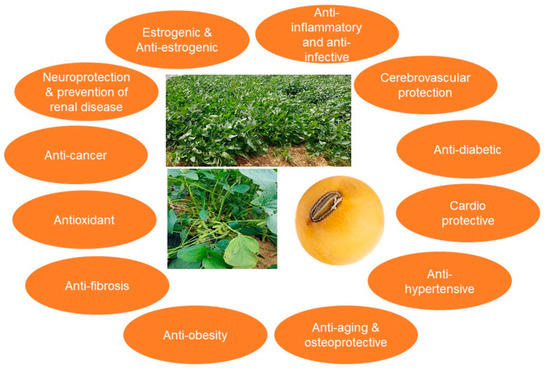
Figure 2. Potential beneficial health effects of soybean molecules.
Table 1. Concentration of nutritional components of soybean [1].
| Component | Nutritional Value (Per 100 g) |
Component | Nutritional Value (Per 100 g) |
|---|---|---|---|
| Carbohydrates | 30.20 g | Glycine | 1.88 g |
| Sugars | 7.30 g | Proline | 2.38 g |
| Protein | 36.49 g | Serine | 2.36 g |
| Tryptophan | 0.59 g | Fat | 19.94 g |
| Threonine | 1.77 g | Saturated FA | 2.89 g |
| Isoleucine | 1.97 g | Monounsaturated FA | 4.40 g |
| Leucine | 3.31 g | Polyunsaturated FA | 11.26 g |
| Lysine | 2.71 g | Water | 8.54 g |
| Methionine | 0.55 g | Vitamin A | 0.001 g |
| Phenylalanine | 2.12 g | Vitamin B6 | 0.006 g |
| Tyrosine | 1.54 g | Vitamin C | 0.047 g |
| Valine | 2.03 g | Vitamin K | 0.277 g |
| Arginine | 3.15 g | Calcium | 1.57 g |
| Histidine | 1.10 g | Magnesium | 0.28 g |
| Alanine | 1.92 g | Phosphorous | 0.704 g |
| Aspartate | 5.12 g | Sodium | 1.797 g |
| Glutamate | 7.87 g | Zinc | 0.002 g |
| Total calories | 466 kcal | ||
Interestingly, certain compounds in soybean, such as lectin and trypsin inhibitors, were originally reported as harmful substances; however, new physiological functions, including the prevention and improvement of diabetes and antitumor activity, have been identified [22][23]. Moreover, phospholipids, which are also abundant in soybean, reduce plasma lipid and total cholesterol levels [24]. Soybean oligosaccharides have the ability to promote the proliferation of probiotic bacteria, such as Bifidobacterium and Lactobacillus spp. [25][26]. Additionally, the low molecular weight compounds in soybean have demonstrated various functions [5][27]. For instance, phytic acid, an inositol with six attached phosphates, saponin, and isoflavone, which are primarily responsible for the bitter taste of soybean, have also exhibited antitumor and antioxidant properties [15][16][17][18][19][20][21]. The primary aim of this review is to highlight the novel functionality of various soybean-derived molecules that have recently received immense attention.
Most plants contain antioxidants, referred to as phenolic compounds (or phenolics), that include flavonoids, hydroxycinnamic acid derivatives, phenolic acids, and tannic acid [28]. Tannic acid is a naturally occurring polyhydroxyl phenol ester of gallic acid [29]. In addition, soybeans contain isoflavone, a derivative of phenolic acids and flavonoids [30].
Soybeans contain eight phenolic acids, namely, p-hydroxy benzoic acid, chlorogenic acid, cinnamic acid, ferulic acid, gentisic acid, salicylic acid, syringic acid, and vanillic acid (Figure 3) [31][32]. Chlorogenic acid is hydrolyzed to form caffeic acid, both of which cause browning, a harmful effect in food, that leads to nutrient loss and affects color and flavor [33]. The removal of phenolics with activated carbon has been shown to increase flavor and improve digestibility in vitro [34]. Conversely, caffeic acid and chlorogenic acid also have the potential to block nitrosamine genesis both in vitro and in vivo [35]. In addition, these phenolics inhibit the metabolism of aflatoxin B1 in rat liver [36]. Phenolic acid can also act as an antioxidant to inhibit DNA damage caused by reactive oxygen species [37].
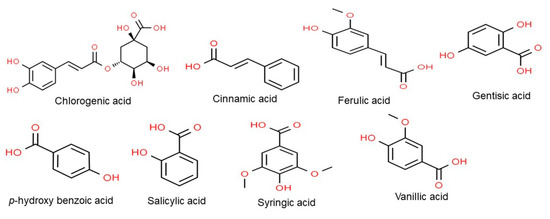
Figure 3. Chemical structure of the major classes of phenolic acids. Structures were drawn using Chem Spider tool.
Isoflavones are phytoestrogens which, along with lignans, are found in plants [30]. These are phytochemicals that have physiological activity similar to estrogen and are activated by the intestinal flora [12][30]. Soybean hypocotyls contain many isoflavones that are classified into four categories based on their chemical structures: (i) aglycons including daidzein, genistein, and glycitein; (ii) glycosides including daidzin, genistin, and glycitin; (iii) three types of acetyl glycosides; and (iv) three types of manonyl glycosides (Figure 4) [12][38]. According to several studies, isoflavones have the ability to activate estrogen receptors in the vagina, oocytes, and mammary glands, and can possess estrogen or antiestrogen properties depending on the physiological environment or their chemical structure [39][40]. For instance, isoflavone is an antiestrogen that reduces the risk of breast and prostate cancers [41][42], and also has antioxidant effects similar to vitamin E and C in vivo and in vitro [43][44]. Furthermore, isoflavone is produced by an oncogene and functions as an inhibitor of tyrosine protein kinase [45]. Among the soybean isoflavones, genistein inhibits the growth of cells that cause breast, colon, lung, prostate, and skin cancers in vitro (Figure 5) [36][46]. In addition, genistein inhibits the formation of boils by preventing vasculogenesis, thus blocking the supply of oxygen or nutrients [47].
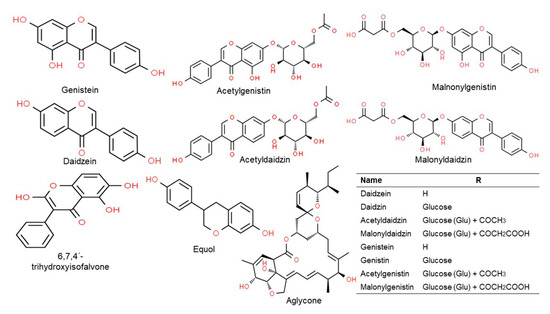
Figure 4. Chemical structure of the major classes of isoflavones. Structures were drawn using Chem Spider tool.
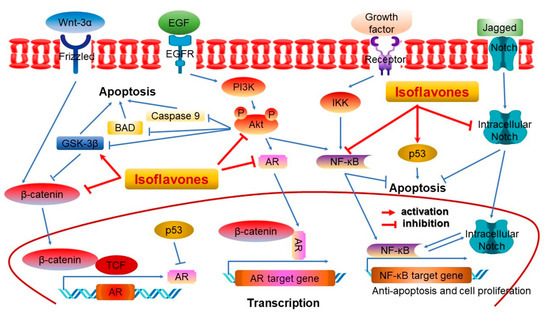
Figure 5. Schematic of multiple signaling pathways involved in isoflavone-induced cancer cell death [30]. Wnt-3α, a protein of the Wnt family, plays critical roles in regulating pleiotropic cellular functions [30]. AR, androgen receptor; Akt, a serine/threonine-specific protein kinase known as a protein kinase B; BAD, Bcl2-associated agonist of cell death; GSK-3β, glycogen synthase kinase 3 beta; EGF, epidermal growth factor; EGFR, epidermal growth factor receptor; TCF, T-cell specific transcription factor; IKK, IκB kinase; p53, tumor protein-53; β-catenin, a core component of the cadherin protein complex; PI3K, phosphatidylinositol-3-kinase; NF-κB, nuclear factor kappa light-chain-enhancer of activated B cells; Notch, a family of type-1 transmembrane proteins; →, activation; ⊥, inactivation. Figure adapted from Li, Y. et al. [30].
Additionally, studies investigating the effects of isoflavone ingestion in Western women have shown that isoflavones affect the menstrual cycle, such that it reduces the risk of breast cancer [48]. Furthermore, isoflavones can have weak estrogenic effect and can reduce the severity of symptoms associated with menopause, without eliciting any negative side effects [30][49]. Isoflavones reduce blood cholesterol by as much as 35%, suggesting their potential as cholesterol-lowering agents [50], while casein, an animal protein, has been found to increase blood cholesterol [51]. In people with insufficient protein intake, protein is generated from accumulated fat [1]. Since the required fat is transported via blood vessels, there is a corresponding increase in fat levels in the blood, which consequently increases blood cholesterol [52]. Thus, consuming high-quality soy protein helps to lower blood cholesterol.
In the United States, approximately 15% of women who have entered menopause receive estrogen administration as hormone therapy [53]. However, estrogen administration increases the likelihood of cancer in reproductive organs [54]; thus, soybean, a natural food, is gradually being considered as a potential substitute for estrogen in this population [6]. Estrogen also lowers the risk of osteoporosis by promoting vitamin D activity, which prevents calcium elution of bones and increases calcium absorption [55]. Specifically, the isoflavones in soybeans are structurally and functionally similar to estrogen, which is why they are also referred to as phytoestrogens [30]. In fact, isoflavones have been highlighted as a potential source of estrogen that does not elicit negative side effects [30]. In addition, isoflavones exert excellent anticancer effects; most of the anticancer effects of isoflavones are produced by genistein [30][56]. Although genistein has been primarily investigated in breast cancer, it has been shown to weakly bind estrogen receptors and promote normal cell division while repressing cancer cell division [57]. Isoflavones also alleviate hot flashes associated with menopause without inducing hyperlipidemia or altering the muscle layers in the breast and uterus, which are common side effects observed following estrogen administration [49][58]. Furthermore, isoflavones prevent bone reabsorption and increase bone density to prevent osteoporosis, which is common in older women [20][59]. The physiological roles of isoflavones are summarized in Figure 6.